Soyuz TMA-03M brings three station fliers back to Earth (UPDATED)
Editor's note...
CBS News
Three departing station fliers strapped into a Soyuz ferry craft, fired the ship's braking rockets and plunged back to Earth early Sunday, landing in Kazakhstan to close out a six-month stay aboard the International Space Station.
Descending through a partly cloudy sky under a red-and-white parachute, the Soyuz TMA-03M command module carrying outgoing Expedition 31 commander Oleg Kononenko, European Space Agency astronaut Andre Kuipers and NASA flight engineer Donald Pettit settled to a jarring rocket-assisted touchdown near Dzhezkazgan, Kazakhstan, at 4:14 a.m. EDT (GMT-4; 2:14 p.m. local time).
Russian recovery crews stationed nearby rushed to the spacecraft and opened the main hatch within minutes to begin assisting the station fliers as they began their re-adaptation to gravity after 193 days in the weightlessness of space.
Because of the entry trajectory and the location of ground stations, Russian flight controllers were unable to communicate with the crew during the final stages of the descent, but recovery personnel reported no problems as the spacecraft made an on-target landing.
Within a half hour or so, all three crew members had been helped out of the cramped descent module. Kononaneko and Kuipers appeared tired but in good spirits as they relaxed in lounge chairs set up near the capsule.
Pettit could be seen during his initial exit from the spacecraft, but he was not seen again until the trio was being moved to an inflatable tent for initial medical checks. As he was carried past a camera, he appeared to be resting with his eyes closed.
Kononenko, Kuipers and Pettit were to be flown by helicopter to Karaganda. From there, Kononenko will be flown to Star City near Moscow while Kuipers and Pettit will board a NASA jet for a flight back to Houston for debriefing and reunions with friends and family.
Mission duration was 193 days since blastoff Dec. 21, giving Kononenko a cumulative total time in space of 392 days over two flights. Kuipers has now logged 204 days in space during two missions while Pettit's total stands at 370 days over three space missions.
Re-entry preparations began late Saturday when Kononenko, Pettit and Kuipers bid Expedition 32 commander Gennady Padalka, Sergei Revin and Joseph Acaba farewell and floated into the Soyuz TMA-03M spacecraft just after 9:30 p.m. After donning Russian pressure suits, they undocked from the station's Rassvet module at 12:48 a.m. Sunday.
Before moving away for re-entry, Kononenko tested a new digital autopilot that would permit a manual docking, if required, without requiring the lab crew to re-orient the station.
He then moved the Soyuz TMA-03M spacecraft to a point just over 6 miles from the station to prepare for re-entry. A four-minute 15-second deorbit rocket firing starting at 3:19 a.m. slowed the spacecraft by about 258 mph, just enough to drop the far side of its orbit deep into the atmosphere for a landing in Kazakhstan.
Twenty-four minutes after the retro firing, the three modules making up the Soyuz TMA-03 spacecraft separated and the central descent module carrying the crew was oriented heat shield forward, plunging into the discernible atmosphere at an altitude of 61.5 miles around 3:51 a.m. The main parachute opened about eight minutes later at an altitude of 6.7 miles.
"We work together to get the spacecraft back home, starting off with undocking," Pettit said in a recent interview. "We get inside, we close the hatch, we have to do a leak check, make sure the hatches don't leak. Then we strap in and undock. Then we do a de-orbit burn. As we hit the atmosphere, the spacecraft separates so only the descent module comes through the atmosphere in one piece and then our parachute comes out and (we) go thump, roll, roll, on the steppe of Kazakhstan."
During his two space station missions, Pettit gained a wide following on the ground for so-called "Saturday morning science" demonstrations, downlinking video of innovative experiments that demonstrated a variety of microgravity phenomena. He also posted spectacular photos and video of Earth and space, including the recent transit of Venus.
Asked what his favorite targets were, Pettit told an interviewer "that's like asking what's your favorite food. It kind of depends on your mood."
"Probably the transit of Venus is pretty high on the list," he said. "The solar eclipse is another one, this is the second solar eclipse I've seen, both of them have been from space. And then aurora borealis, aurora australis is just amazing, each display is different and captivates you."
Another favorite target: polar mesospheric clouds, or noctilucent clouds, made up of ice crystals at extreme altitudes that are only visible when the sun is below the horizon and the lower layers of the atmosphere are in Earth's shadow.
"This mission, I've been fortunate enough to see both southern hemisphere clouds, which are only visible during the winter time, and now we're into the summer time northern hemisphere noctilucent cloud season," Pettit said. "So to be able to see both of these clouds in one mission is, I think, a real treat."
Another highlight of the crew's stay in space was the arrival of the first commercial cargo craft -- the SpaceX Dragon -- in May. Pettit and Kuipers captured the spacecraft using the station's robot arm.
"It was a great moment," Kuipers said. "This will be the future of spaceflight, it will be commercial companies taking over. That's the idea. (Government) agencies will continue to explore and go further, and then commercial industry on the ground will take over the use of low-Earth orbit. So I think this was a great moment, the first step of a new era."
Pettit agreed, saying "I hope in the future that these things become so routine that journalists just go ho-hum, another visiting commercial vehicle's docked at the space station, and they'll hardly take note. That I think would be a sign of the technology moving in the right direction."
Asked if he was ready to return to Earth, Kuipers said he was looking forward to seeing his family again. But he added, "I would love to stay longer. Or better, to come back here. It would be great to be up here to serve two, three weeks a year as a holiday after this. It's a fantastic place. Yeah, I have to go back, but I'd like to come back, too."
Joked Pettit: "I just ran out of vitamin supplements, so I figure it's time for me to go home."
During a brief ceremony Friday, Kononenko turned over command of the space station to Gennady Padalka, who was launched to the station May 15 aboard the Soyuz TMA-04M spacecraft along with cosmonaut Sergei Revin and NASA flight engineer Joseph Acaba.
"It's been a privilege to serve as commander of the space station and to work with such a good crew as well as such dedicated ground support staff," Kononenko said. "The station is an accomplishment, the result of the cooperative effort of mankind which has expanded understanding between individual people and nations. The exploration of space is one of the great opportunities for us to test ourselves and our limits and to focus our energies into positive efforts that will benefit everyone. So, Gennady, it's your time to be commander of ISS."
The two Russians shook hands, and Padalka thanked Kononenko and he crewmates "for a great job keeping space station in great operational condition. And from our (crew) I would like to say we will continue to stick to this high standard."
Padalka, Revin and Acaba will have the space station to themselves until July 17 when the Soyuz TMA-05M spacecraft is scheduled to arrive carrying cosmonaut Yuri Malenchenko, NASA astronaut Sunita Williams and Japanese astronaut Akihiko Hoshide.
- Posted at 01:40 PM EDT, 06/30/12: Outgoing station astronauts prep Soyuz for return to Earth
- Updated at 10:05 PM EDT, 06/30/12: Soyuz hatch closed
- Updated at 12:55 AM EDT, 07/01/12: Soyuz TMA-03M undocks from space station
- Updated at 05:00 AM EDT, 07/01/12: Soyuz TMA-03M lands in Kazakhstan
CBS News
Three departing station fliers strapped into a Soyuz ferry craft, fired the ship's braking rockets and plunged back to Earth early Sunday, landing in Kazakhstan to close out a six-month stay aboard the International Space Station.
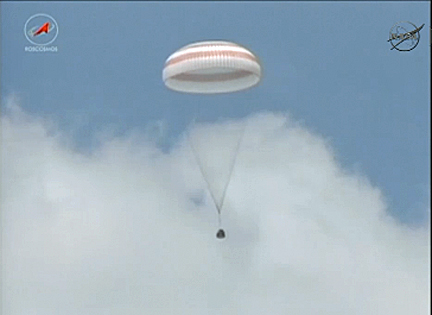 |
| The Soyuz TMA-03M descends toward landing in Kazakhstan. (Credit: NASA TV) |
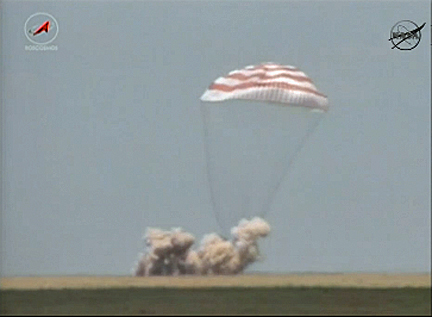 |
| Touchdown! (Credit: NASA TV) |
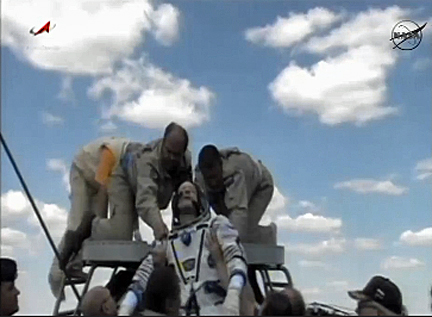 |
| NASA astronaut Donald Pettit is lowered from the Soyuz descent module to the ground. (Credit: NASA TV) |
Within a half hour or so, all three crew members had been helped out of the cramped descent module. Kononaneko and Kuipers appeared tired but in good spirits as they relaxed in lounge chairs set up near the capsule.
Pettit could be seen during his initial exit from the spacecraft, but he was not seen again until the trio was being moved to an inflatable tent for initial medical checks. As he was carried past a camera, he appeared to be resting with his eyes closed.
Kononenko, Kuipers and Pettit were to be flown by helicopter to Karaganda. From there, Kononenko will be flown to Star City near Moscow while Kuipers and Pettit will board a NASA jet for a flight back to Houston for debriefing and reunions with friends and family.
Mission duration was 193 days since blastoff Dec. 21, giving Kononenko a cumulative total time in space of 392 days over two flights. Kuipers has now logged 204 days in space during two missions while Pettit's total stands at 370 days over three space missions.
Re-entry preparations began late Saturday when Kononenko, Pettit and Kuipers bid Expedition 32 commander Gennady Padalka, Sergei Revin and Joseph Acaba farewell and floated into the Soyuz TMA-03M spacecraft just after 9:30 p.m. After donning Russian pressure suits, they undocked from the station's Rassvet module at 12:48 a.m. Sunday.
Before moving away for re-entry, Kononenko tested a new digital autopilot that would permit a manual docking, if required, without requiring the lab crew to re-orient the station.
He then moved the Soyuz TMA-03M spacecraft to a point just over 6 miles from the station to prepare for re-entry. A four-minute 15-second deorbit rocket firing starting at 3:19 a.m. slowed the spacecraft by about 258 mph, just enough to drop the far side of its orbit deep into the atmosphere for a landing in Kazakhstan.
Twenty-four minutes after the retro firing, the three modules making up the Soyuz TMA-03 spacecraft separated and the central descent module carrying the crew was oriented heat shield forward, plunging into the discernible atmosphere at an altitude of 61.5 miles around 3:51 a.m. The main parachute opened about eight minutes later at an altitude of 6.7 miles.
"We work together to get the spacecraft back home, starting off with undocking," Pettit said in a recent interview. "We get inside, we close the hatch, we have to do a leak check, make sure the hatches don't leak. Then we strap in and undock. Then we do a de-orbit burn. As we hit the atmosphere, the spacecraft separates so only the descent module comes through the atmosphere in one piece and then our parachute comes out and (we) go thump, roll, roll, on the steppe of Kazakhstan."
During his two space station missions, Pettit gained a wide following on the ground for so-called "Saturday morning science" demonstrations, downlinking video of innovative experiments that demonstrated a variety of microgravity phenomena. He also posted spectacular photos and video of Earth and space, including the recent transit of Venus.
Asked what his favorite targets were, Pettit told an interviewer "that's like asking what's your favorite food. It kind of depends on your mood."
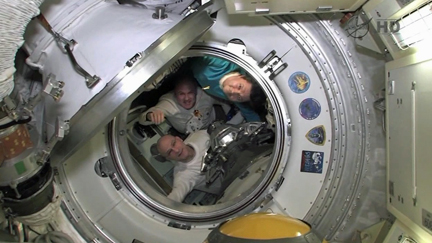 |
| Departing station crew members wave farewell from inside the Soyuz TMA-03M spacecraft. Clockwise from bottom: NASA astronaut Donald Pettit, European Space Agency flight engineer Andre Kuipers and Soyuz TMA-03M commander Oleg Kononenko. (Credit: NASA TV) |
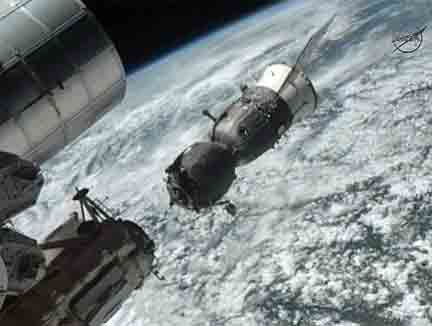 |
| The Soyuz TMA-03M spacecraft undocks from the space station's Rassvet module. (Credit: NASA TV) |
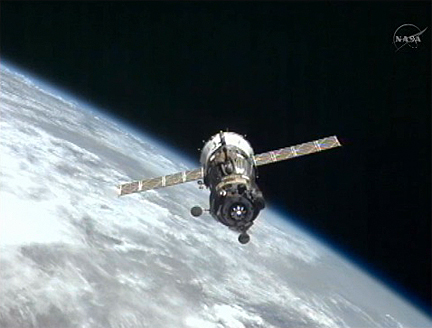 |
| With commander Oleg Kononenko at the controls, the Soyuz TMA-03M spacecraft backs away. (Credit: NASA TV) |
Another highlight of the crew's stay in space was the arrival of the first commercial cargo craft -- the SpaceX Dragon -- in May. Pettit and Kuipers captured the spacecraft using the station's robot arm.
"It was a great moment," Kuipers said. "This will be the future of spaceflight, it will be commercial companies taking over. That's the idea. (Government) agencies will continue to explore and go further, and then commercial industry on the ground will take over the use of low-Earth orbit. So I think this was a great moment, the first step of a new era."
Pettit agreed, saying "I hope in the future that these things become so routine that journalists just go ho-hum, another visiting commercial vehicle's docked at the space station, and they'll hardly take note. That I think would be a sign of the technology moving in the right direction."
Asked if he was ready to return to Earth, Kuipers said he was looking forward to seeing his family again. But he added, "I would love to stay longer. Or better, to come back here. It would be great to be up here to serve two, three weeks a year as a holiday after this. It's a fantastic place. Yeah, I have to go back, but I'd like to come back, too."
Joked Pettit: "I just ran out of vitamin supplements, so I figure it's time for me to go home."
During a brief ceremony Friday, Kononenko turned over command of the space station to Gennady Padalka, who was launched to the station May 15 aboard the Soyuz TMA-04M spacecraft along with cosmonaut Sergei Revin and NASA flight engineer Joseph Acaba.
"It's been a privilege to serve as commander of the space station and to work with such a good crew as well as such dedicated ground support staff," Kononenko said. "The station is an accomplishment, the result of the cooperative effort of mankind which has expanded understanding between individual people and nations. The exploration of space is one of the great opportunities for us to test ourselves and our limits and to focus our energies into positive efforts that will benefit everyone. So, Gennady, it's your time to be commander of ISS."
The two Russians shook hands, and Padalka thanked Kononenko and he crewmates "for a great job keeping space station in great operational condition. And from our (crew) I would like to say we will continue to stick to this high standard."
Padalka, Revin and Acaba will have the space station to themselves until July 17 when the Soyuz TMA-05M spacecraft is scheduled to arrive carrying cosmonaut Yuri Malenchenko, NASA astronaut Sunita Williams and Japanese astronaut Akihiko Hoshide.